Asteroid
Research
"We must make it a mission to find asteroids before they find us."

Lord Martin Rees
Astronomer Royal of the UK
Roger Harris, CC BY 3.0
via Wikimedia Commons
"We must make it a mission to find asteroids...
before they find us."

Lord Martin Rees
Astronomer Royal of the UK
Roger Harris, CC BY 3.0
via Wikimedia Commons
Stony Ridge Asteroid Bits
Importance and Ties to Stony Ridge
Asteroids, sometimes referred to as minor planets, are small bodies of rocky material with most – but not all – residing in orbits between Mars and Jupiter.
The study of asteroids has two main purposes. One is to simply answer curiosities about the birth and evolution of the solar system because an asteroid is either a pristine remnant from that primordial era or the liberated material from a parent object. The other, more practical (and somewhat related) reason to observe and register these objects, is to identify candidates with the potential to strike the Earth and render catastrophic destruction to life and the ecosystem. Stony Ridge Observatory has made contributions in both areas, beginning in the late 1970s.
Not only have SRO observers provided telescopic measurements that helped to refine the size and shape of the particular body being studied, but the same 30-inch Carroll telescope has been used to discover new members of this class and help improve the orbital data of those already catalogued. Currently, there are over 1.1 million known asteroids, yet how many are waiting to be discovered, and how many of those might pose a danger to us? These are questions that simply must be answered.

Tracking Trouble?
This asteroid (2014JO25) passed within one million miles of Earth - a safe distance to be sure. This time...
It belongs to a class of asteroids whose orbits can lie very near the Earth and are officially deemed "PH - Potentially Hazardous."
This animation was made from a series of sixty photographs taken over an interval of around 24 minutes on April 19, 2017 from Riga, Latvia using a 12-inch amateur telescope. The streaking starfield (caused by keeping the telescope pointed at the asteroid and not the stars) creates a cartoonish element of velocity which can be misleading. But make no mistake, an impact with such an object, at whatever speed of collision, would unleash devastating damage over a wide area.

Tracking Trouble?
This asteroid (2014JO25) passed within one million miles of Earth - a safe distance to be sure. This time...
It belongs to a class of asteroids whose orbits can lie very near the Earth and are officially deemed "PH - Potentially Hazardous."
This animation was made from a series of sixty photographs taken over an interval of around 24 minutes on April 19, 2017 from Riga, Latvia using a 12-inch amateur telescope. The streaking starfield (caused by keeping the telescope pointed at the asteroid and not the stars) creates a cartoonish element of velocity which can be misleading. But make no mistake, an impact with such an object, at whatever speed of collision, would unleash devastating damage over a wide area.
Kobalts
CC BY-SA 4.0, via Wikimedia Commons
Nomenclature
Many asteroids have proper names prefixed with the chronological order of discovery. For example, consider “3 Juno,” a massive, relatively bright body that was the third asteroid found and the subject of a major eclipsing event (occultation) seen from SRO.
The official naming process begins with a temporary designation encoded with the year and half-month (first or second) of discovery and includes a chronological component. Once the object has met the criteria to be considered “known,” the naming can be finalized and simplified if the discoverer(s) so choose.
They are allowed to propose names for formal adoption and enjoy a fair amount of latitude in their selections. Approved names have ranged from the honorific (144633 georgecarroll) to the whimsical (24680 alleven) and need not refer to anyone or anything connected to science. The chance to christen an asteroid has, in times past, provided a little extra incentive to those who search for them, especially amateurs. However, the window of opportunity for that is fast closing because of the maturation and comprehensive scope of automated detection methods.
Published Asteroid Research from Stony Ridge
A Major Occultation
Optical telescopes have traditionally served as the workhorse tools for asteroid discovery and study and, despite advances in remote sensing and sampling, they still play a primary role.
In this regard, one of the first such applications of the Carroll 30-inch reflector was the 1979 observation of a large asteroid as it passed directly in front of a star, blotting its light for several seconds. This effort was part of a highly coordinated collaboration in which individuals and institutions, dispersed along a line perpendicular to the path of the “shadow,” timed the duration of the eclipse.
Such an event, called an occultation, is one of the means used to determine the size and shape of an object.
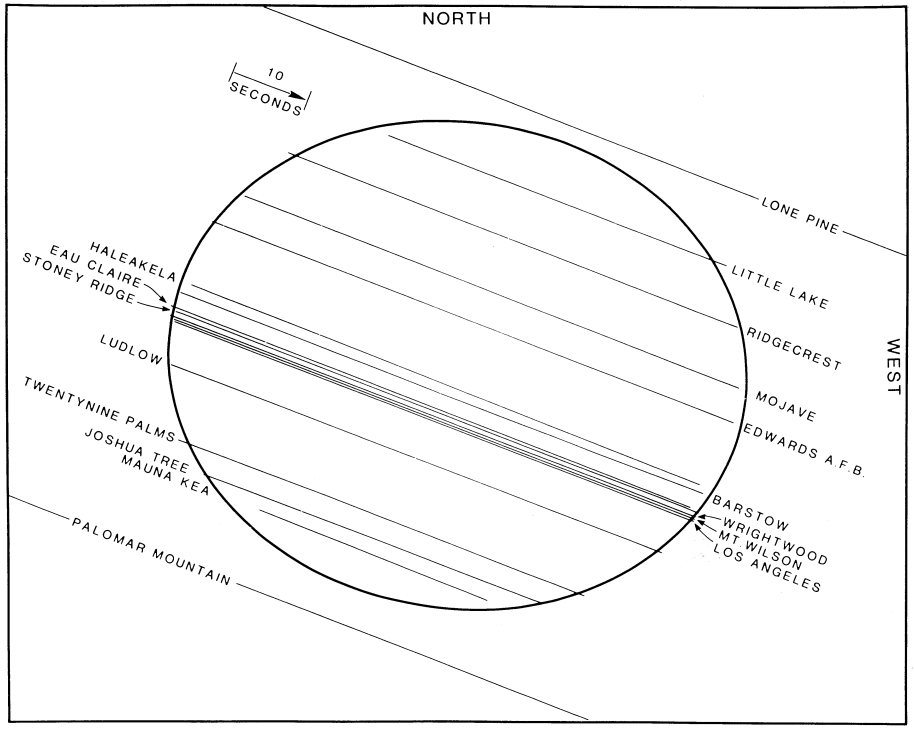
Data from the 1979 Occultation of 3 Juno
Shortly after 9h10m UT on the morning of 11 December, 1979, the asteroid Juno occulted a ninth magnitude star (AG+0° 1022, in Canis Majoris) as observed by SRO's John Faulkner. His photometric data showed that the star "disappeared" for around 67 seconds.
This graphic (from the The Astronomical Journal Volume 86, Number 2, page 112) compares Faulkner's data (Stoney [sic] Ridge) with that of others who observed the event and includes both visual timings and those recorded electronically. His measurements correlate well with others made in proximity to the centerline of the occultation path. That ground track stretched northeastward from Hawaii, through southern California to points north of the "Four Corners" region, into the Great Plains and upper Midwest, then finally into Ontario.

Data from the 1979 Occultation of 3 Juno
Shortly after 9h10m UT on the morning of 11 December, 1979, the asteroid Juno occulted a ninth magnitude star (AG+0° 1022, in Canis Majoris) as observed by SRO's John Faulkner. His photometric data showed that the star "disappeared" for around 67 seconds.
This graphic (from the The Astronomical Journal Volume 86, Number 2, page 112) compares Faulkner's data (Stoney [sic] Ridge) with that of others who observed the event and includes both visual timings and those recorded electronically. His measurements correlate well with others made in proximity to the centerline of the occultation path. That ground track stretched northeastward from Hawaii, through southern California to points north of the "Four Corners" region, into the Great Plains and upper Midwest, then finally into Ontario.
https://library2.smu.ca/bitstream/handle/01/26050/
Dupuy_David_L_article_1981.pdf?sequence=1
Continuing Asteroid Research Opportunities from Stony Ridge Observatory
Film cameras, once de-facto standard equipment for finding new asteroids, began to lose their monopoly in the 1990s. Charge-Coupled Device (CCD) technology, highly sensitive and delivering immediate results, found a ready-made application in astronomical photography.
This paradigm shift in detection reached SRO and began to have fruitful impact. The discoveries which followed are described below.
Are occultation observations still needed?
The International Occultation and Timing Association (IOTA) says
*YES*
Amateurs can contribute to science! How?...
SRO and "New" Asteroids
Finding an Asteroid...Before it Finds Us
As mentioned above, conventional photography was at the heart of asteroid discovery and had been for many, many years. The usual tools of detection were applied in one of two ways. In the first case, a streak is seen on a long exposure photograph which captures the path of an interloper as the telescope tracks the stars. The other way to find an intruder is to take two pictures of the same area of the sky, separated by some time interval, and then look for an object that has moved.
Most discoveries are made by “the two photo” method and various tools have been employed to facilitate that approach. The one pictured below is one such device and is quite historic – it was used in Arizona to “expand” the Sun’s family.
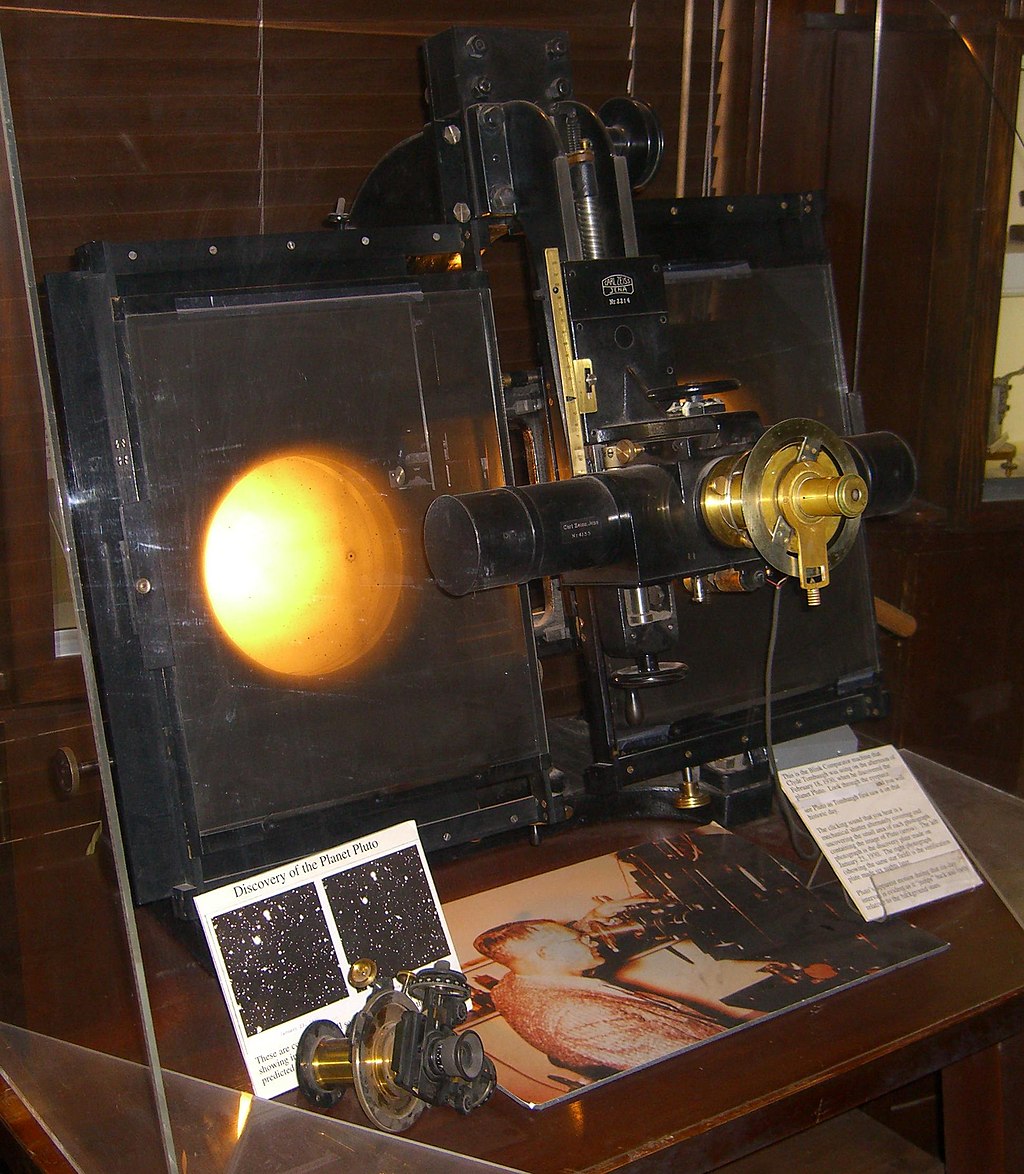
"Don't Blink and You'll Miss It...?!"
This machine, called a "Blink Comparator," was used to find new solar system objects, including asteroids.
The general approach consisted of obtaining two images of the same region of the sky,
the second captured at some interval (usually a few days) after the first.
The astronomer then mounted the media - photographic glass plates in this case - into the machine, carefully aligning them so that the same patch of sky on both plates will be magnified. In so doing, a comparison can be made to see if any object moved, emerged, or vanished.
The device would illuminate both plates simultaneously and project each image to a single eyepiece. However, a shutter would alternatively
block the light from each plate "blinking" one against the other in the hopes that some change between the plates would pop-out from the
motionless stellar background. The operator painstakingly scours one small area of the plate(s) before moving onto the adjacent region until the entire plate had been examined.
Clyde Tombaugh used this very machine at Lowell Observatory and discovered many objects with it, including Pluto in 1930. Each plate measured 14x17 inches and had been exposed for around an hour, most of them recording hundreds of thousands of stars. On the discovery plates, Pluto had moved about 1/8 of an inch in the six days between captures, drifting slowly among the dense star fields of Gemini.
Like the men who built SRO, Tombaugh was an amateur and telescope maker, a Kansas farm boy who had impressed Lowell's staff with drawings of the planets before being invited to Flagstaff to work as an assistant. He was just 24 years old as he blinked - and didn't miss - "Planet X." As with George Carroll, he has a permanent place among the stars: a portion of his remains was aboard NASA's New Horizons spacecraft as it flew by "his" *planet on July 14, 2015.
In the 1990s, SRO's John Rogers implemented a computerized version of this machine in which two digital images were swapped in and out of video memory to create on screen blinking, greatly enabling the discoveries
mentioned on this webpage. It can be said that his creation was both BASIC and clever!
*In August, 2006 the International Astronomical Union reclassified Pluto as a "dwarf planet."

"Don't Blink and You'll Miss It...?!"
This machine, called a "Blink Comparator," was used to find new solar system objects, including asteroids.
The general approach consisted of obtaining two images of the same region of the sky,
the second captured at some interval (usually a few days) after the first.
The astronomer then mounted the media - photographic glass plates in this case - into the machine, carefully aligning them so that the same patch of sky on both plates will be magnified. In so doing, a comparison can be made to see if any object moved, emerged, or vanished.
The device would illuminate both plates simultaneously and project each image to a single eyepiece. However, a shutter would alternatively
block the light from each plate "blinking" one against the other in the hopes that some change between the plates would pop-out from the
motionless stellar background. The operator painstakingly scours one small area of the plate(s) before moving onto the adjacent region until the entire plate had been examined.
Clyde Tombaugh used this very machine at Lowell Observatory and discovered many objects with it, including Pluto in 1930. Each plate measured 14x17 inches and had been exposed for around an hour, most of them recording hundreds of thousands of stars. On the discovery plates, Pluto had moved about 1/8 of an inch in the six days between captures, drifting slowly among the dense star fields of Gemini.
Like the men who built SRO, Tombaugh was an amateur and telescope maker, a Kansas farm boy who had impressed Lowell's staff with drawings of the planets before being invited to Flagstaff to work as an assistant. He was just 24 years old as he blinked - and didn't miss - "Planet X." As with George Carroll, he has a permanent place among the stars: a portion of his remains was aboard NASA's New Horizons spacecraft as it flew by "his" *planet on July 14, 2015.
In the 1990s, SRO's John Rogers implemented a computerized version of this machine in which two digital images were swapped in and out of video memory to create on screen blinking, greatly enabling the discoveries
mentioned on this webpage. It can be said that his creation was both BASIC and clever!
*In August, 2006 the International Astronomical Union reclassified Pluto as a "dwarf planet."
Media Credit:
Pretzelpaws with a Casio Exilim EX-Z750 camera. Cropped 8/16/05 using the GIMP
CC BY-SA 3.0, via Wikimedia Commons
Discoveries from Stony Ridge

Discovery Image: Asteroid 144633 Georgecarroll
FOFU Team
This animation shows the difference between a raw, unprocessed image and the after effects of historgram transformation- "boosting." The image is one of three used to discover asteroid 2004 FH80 which later became named for George Carroll. The object's motion among the trio confirmed the find.
The camera used for this 120 second exposure through the 30-inch was electronic, a wonderfully capable CCD device but worthless without software to manipulate the digital data it records. There among the 1s and 0s is the weakly accumulated representation of the asteroid's faint light. At magnitude 15, it is roughly 160,000 times fainter than Polaris, the "North Star."
The goal here is to hammer home the notion that this kind of research isn't easy and to top it off, all of the low-hanging fruit - the bright asteroids - were discovered a long time ago.
For visual analysis, even after the signal has been amplified through image processing, you are left to sort through a maze of ghostly smudges, oblong blobs of light smeared by atmospheric turbulence, pixels that are lit due to defects, artifacts due to dust on the sensor, and a few other obstacles there to confuse and confound.
The wonderful thing about digital data is you can process it mathematically, of course. Images like the one presented here feed specialized software targeted to comet and small planet astrometry - a huge help in data collection and refinement. These programs which automatically sift through the data of raw imagery can largely automate what used to be a manual exercise not all that long ago. In addition, with access to catalogued data, the same software can make identification of any known objects that also might appear. This is but one application of computerization for which astronomy seems tailor made.

Discovery Image: Asteroid 144633 Georgecarroll
FOFU Team
This animation shows the difference between a raw, unprocessed image and the after effects of historgram transformation- "boosting." The image is one of three used to discover asteroid 2004 FH80 which later became named for George Carroll. The object's motion among the trio confirmed the find.
The camera used for this 120 second exposure through the 30-inch was electronic, a wonderfully capable CCD device but worthless without software to manipulate the digital data it records. There among the 1s and 0s is the weakly accumulated representation of the asteroid's faint light. At magnitude 15, it is roughly 160,000 times fainter than Polaris, the "North Star."
The goal here is to hammer home the notion that this kind of research isn't easy and to top it off, all of the low-hanging fruit - the bright asteroids - were discovered a long time ago.
For visual analysis, even after the signal has been amplified through image processing, you are left to sort through a maze of ghostly smudges, oblong blobs of light smeared by atmospheric turbulence, pixels that are lit due to defects, artifacts due to dust on the sensor, and a few other obstacles there to confuse and confound.
The wonderful thing about digital data is you can process it mathematically, of course. Images like the one presented here feed specialized software targeted to comet and small planet astrometry - a huge help in data collection and refinement. These programs which automatically sift through the data of raw imagery can largely automate what used to be a manual exercise not all that long ago. In addition, with access to catalogued data, the same software can make identification of any known objects that also might appear. This is but one application of computerization for which astronomy seems tailor made.
These asteroids first became known worlds due to the work of SRO astronomers and the capabilities of the observatory…
55816
In 1995, John Rogers and Jack Child became the first SRO members to regularly observe with a CCD camera affixed to the 30-inch telescope and used this configuration to make discoveries.
Their initial find was made on February 4th. Thus far, it has no permanent identifier beyond the numeric.
55816 is a main belt asteroid that “lives” in the well-populated area between Mars and Jupiter.
10168
Stony Ridge
Later that same night (2.4.1995), Child and Rogers discovered yet another asteroid, provisionally identified as 1995 CN. After confirmation of their find, they chose to commemorate the observatory’s fifteen original members who built both the telescope and the facilities.
Stony Ridge is a main belt asteroid.
144633
Georgecarroll
On March 21, 2004, during an observing run in support of NEAT (Near Earth Asteroid Tracking), FOFU (Faint Object Follow Up) observers were attempting to recover 2002 JV15, an Apollo earth-crosser. Although they were unable to observe it, the “miss” was serendipitous. Their search turned up a new candidate and was provisionally designated 2004 FH80.
After submitting further observations to the Minor Planet Center, a good orbit was determined and subsequently refined with pre and post discovery sightings. The FOFU group was credited with a discovery “by site” (i.e., SRO). All six members were at the telescope.
The observers were able to suggest a name for the new asteroid. It seemed fitting to recognize George Carroll, not only the designer and namesake of the imaging telescope but the driving force most responsible for the completion of SRO. The International Astronomical Union approved the recommendation and now this diminutive body, 4.5km in diameter, named for the father of this observatory, is a child of the Sun.
A short video describing the circumstances of discovery can be found on SRO’s YouTube channel.
Georgecarroll is a main belt asteroid.
327030
Alanmaclure
Three FOFU observers (Brewster, Hobbs, and Sable), at the Carroll 30-inch reflector on September 12, 2004, swept up a minor planet initially designated 2004 RR80.
Once confirmed as a discovery object, they chose to name it after noted astrophotograher Alan McClure whose work, particularly involving comets, was widely published in amateur circles and within the pages of professional journals. Alan had been associated with SRO in the formative days but was not part of the group when the site and instrumentation were being built.
An observation made by John Rogers in 2009 of an object with the preliminary designation of 2009 UH4 was later determined to be the very same 2004 RR80.
Like the other SRO discoveries, Alanmaclure belongs to the main belt family of asteroids.
FOFU - The "Faint Object Follow Up" Campaign
The Orbit Problem...
To assess the risk of collision with Earth, an impactor candidate’s motion must be well understood. A newly discovered minor planet needs additional observation in order to define the six parameters which specify the size, shape, and orientation of its orbit along with the object’s position within it. They can be derived from sufficient data sets consisting of Right Ascension and Declination coordinates plus time.
The number of observations and the time between them must be sufficient in order to be useful. Without them, either the orbit cannot be calculated or the computation lacks enough precision to allow accurate prediction of future threats. Many thousands of asteroids have been “lost” after their discovery because additional observations weren’t made or the collected data too meager.
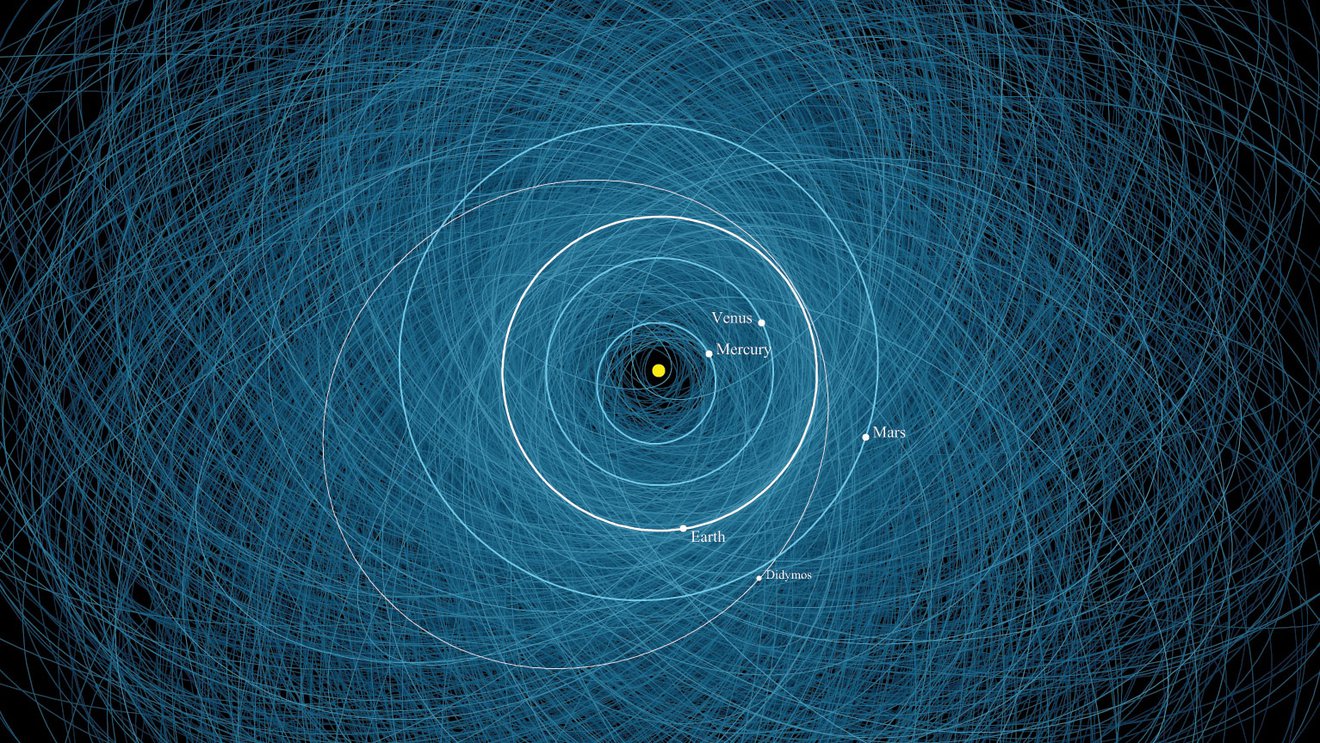
2000+ and Counting...
NASA's Center for Near Earth Object Studies (CNEOS) has identified numerous bodies whose orbits bring them within the vicinity of Earth. Data collection and calculation is now largely automated.
However, the foundational work to comprehensively catalog and determine threat assessment can be traced, at least in part, to the Near Earth Asteroid Tracking (NEAT) program which was assisted by observations from Stony Ridge Observatory.

2000+ and Counting...
NASA's Center for Near Earth Object Studies (CNEOS) has identified numerous bodies whose orbits bring them within the vicinity of Earth. Data collection and calculation is now largely automated.
However, the foundational work to comprehensively catalog and determine threat assessment can be traced, at least in part, to the Near Earth Asteroid Tracking (NEAT) program which was assisted by observations from Stony Ridge Observatory.
Media Credit:
NASA
A NEAT Solution (with help from SRO)
To help catalog and quantify the threats posed by this special class of objects, NASA – through the Jet Propulsion Laboratory – launched the Near Earth Asteroid Tracking (NEAT) program in 1995 under the direction of Dr. Eleanor Helin.
In 2000, SRO members Steve Brewster and John Rogers formed the Faint Object Follow Up (FOFU) project, primarily to support the subsequent observations that would be needed after a body is identified. Here’s how it worked…
From a telescope on Maui, NEAT autonomously collected data then transmitted it to JPL where it was filtered. Assignments were then passed to the FOFU group who proceeded to make additional position measurements. The team eventually expanded to include Dave Hadlen, James Hoff, Sara Martin, and Pam Sable in addition to FOFU founders Brewster and Rogers.
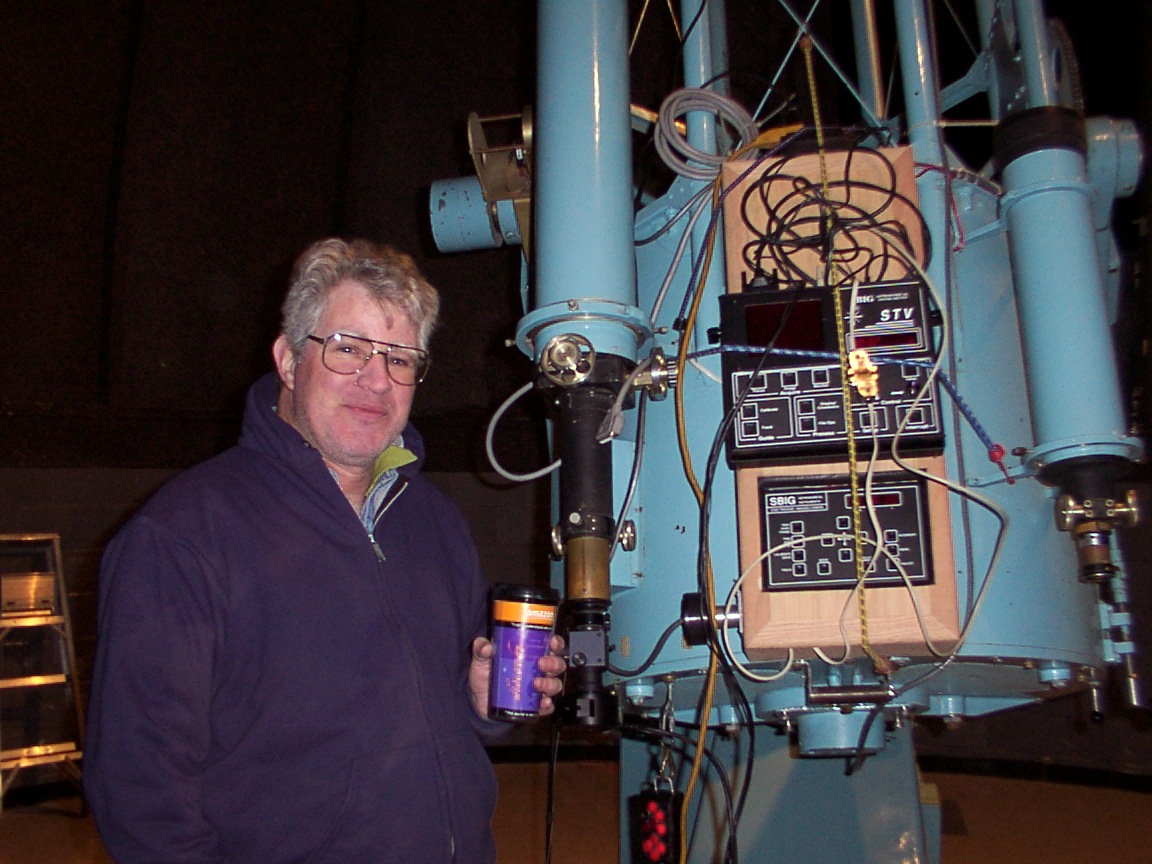
Hunting Gear for Different Kind of Rock Hound
It was FOFU's job to help determine whether space rocks would come crashing to Earth. To do so required fitting the venerable Carroll reflector with modern tools of the trade, in this case an electronic camera with exquisite sensitivity. It afforded the Team quick, digital capture of faint asteroids, data which would then be fed into a computer for extracting positional data to aid in orbit refinement.
FOFU Co-founder Steve Brewster is shown next to the 30-inch in its mission configuration: the CCD detector occupying the high-resolution Cassegrain focus and nearby, the hardware to control it. This research was made possible by several factors which worked in collaboration: the capabilities of a well-constructed, versatile telescope; the high priority of the project; the cooperation in encouragement and financial support of the Principal Investigator, a distinguished NASA scientist and friend of Stony Ridge.

Hunting Gear for Different Kind of Rock Hound
It was FOFU's job to help determine whether space rocks would come crashing to Earth. To do so required fitting the venerable Carroll reflector with modern tools of the trade, in this case an electronic camera with exquisite sensitivity. It afforded the Team quick, digital capture of faint asteroids, data which would then be fed into a computer for extracting positional data to aid in orbit refinement.
FOFU Co-founder Steve Brewster is shown next to the 30-inch in its mission configuration: the CCD detector occupying the high-resolution Cassegrain focus and nearby, the hardware to control it. This research was made possible by several factors which worked in collaboration: the capabilities of a well-constructed, versatile telescope; the high priority of the project; the cooperation in encouragement and financial support of the Principal Investigator, a distinguished NASA scientist and friend of Stony Ridge.
Know the Foes...
Beware the Earth Crossers
Not all asteroids pose a threat, only those whose orbits cross paths with Earth’s orbit. 101955 Bennu is one that does.
The study of its composition would do more than just satisfy an astronomer’s general interest. Such understanding could lead to collision avoidance strategies based on altered orbital mechanics…
Bennu - 360!
Investigate this model of Bennu with your mouse (or finger on touch screens) by picking a point on the object and dragging it.
You can also zoom in and out if you have a wheel on your mouse and have configured it for the zoom function.
Media Credit:
NASA
Material from this asteroid, discovered on September 11, 1999, was harvested by NASA’s OSIRIS-REx spacecraft in 2020 and returned to Earth on September 24, 2023.
Bennu’s orbit takes it in the vicinity of our planet once every six years. Late in the 22nd century, astrometrists estimate it will have a 1 in 2700 chance of impacting our planet. This body is approximately 500m in diameter, considerably taller than the Empire State Building. Considering the speed of collision, this mass would present a lethal amount of kinetic energy.
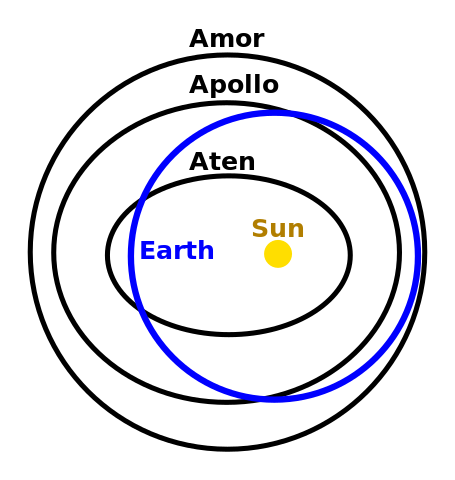
What Makes an Earth Crosser Cross Earth?!
The size and shape of asteroid orbits determines the potential for collision. One necessary characteristic is that the semi-major axis of their elliptical paths be greater than that of the Earth (i.e., > 1 Astronomical Unit).
The second condition is that their perihelion distances - points of closest approach to the Sun - must lie within Earth's aphelion - point of furthest distance to the Sun.
When these conditions are met, the orbits overlap. Apollos and Atens meet this dubious classification and while most of the Amors don't qualify, a few of them do and bear watching.
If we are going to have a “face-to-face” with members of either family, it needs to be at a time and place of our choosing!
That was one of the reasons Bennu was sampled – to help devise a strategy for such an encounter.
Apollo Belvedere. Rome, Vatican Museums, Pius-Clementine Museum.
Sergey Sosnovskiy from Saint-Petersburg, Russia, CC BY-SA 2.0 , via Wikimedia Commons
Berklas, Public domain, via Wikimedia Commons
Know the Foes...
Beware the Earth Crossers
Not all asteroids pose a threat, only those whose orbits cross paths with Earth’s orbit. 101955 Bennu is one that does.
The study of its composition would do more than just satisfy an astronomer’s general interest. Such understanding could lead to collision avoidance strategies based on altered orbital mechanics…
Bennu - 360!
Investigate this model of Bennu with your mouse (or your finger on touch screens) by choosing a point on the object and dragging it.
You can also zoom in and out with a finger pinch or by using your mouse wheel if it’s configured for the zoom function.
Material from this asteroid, discovered on September 11, 1999, was harvested by NASA’s OSIRIS-REx spacecraft in 2020 and returned to earth on September 24, 2023.
Bennu’s orbit takes it in the vicinity of our planet once every six years. Late in the 22nd century, astrometrists estimate it will have a 1 in 2700 chance of impacting Earth. This body is approximately 500m in diameter, taller than the Empire State Building. Considering the speed of collision, this mass would present a lethal amount of kinetic energy.
Apollo Belvedere. Rome, Vatican Museums, Pius-Clementine Museum.
Sergey Sosnovskiy from Saint-Petersburg, Russia, CC BY-SA 2.0 , via Wikimedia Commons
Apollo Belvedere. Rome, Vatican Museums, Pius-Clementine Museum.
Sergey Sosnovskiy from Saint-Petersburg, Russia,
CC BY-SA 2.0 , via Wikimedia Commons

What Makes an Earth Crosser Cross Earth?!
The size and shape of asteroid orbits determines the potential for collision. One necessary characteristic is that the semi-major axis of their elliptical paths be greater than that of the Earth (i.e., > 1 Astronomical Unit).
The second condition is that their perihelion distances - points of closest approach to the Sun - must lie within Earth's aphelion - point of furthest distance to the Sun.
When these conditions are met, the orbits overlap. Apollos and Atens meet this dubious classification and while most of the Amors don't qualify, a few of them do and bear watching.
Berklas, Public domain, via Wikimedia Commons
If we are going to have a “face-to-face” with members of either family, it needs to be at a time and place of our choosing!
That was one of the reasons Bennu was sampled – to help devise a strategy for such an encounter.
Threat Identified...Now What??
Mitigation Strategies to Avoid Earth Impact
Once a threat is detected, what can be done? There are basically two choices: either destroy the incoming target, or “nudge” it so that collision with Earth is averted.
Destruction might seem the preferred option, but this approach carries risk dues to the uncertainty of the resulting debris cloud. For example, assume that you could split the body in half. Might you then have to subsequently target each half?? And so on…
An appreciation for the complexities of orbital mechanics suggest that the better, least disruptive and most effective approach favors disturbing the orbit while leaving the body as intact as possible.

"Bullseye" (as seen from the tip of a DART)
This time lapse covers the last few minutes of flight of the Double Asteroid Redirection Test (DART) vehicle. Its mission: collide at ultra high speed with the moonlet Dimorphos, transferring the spacecraft's kinetic energy to the asteroid with the hope of nudging its orbit. The test was a resounding success, proving the feasibility of the mitigation strategy, at least in favorable cases.

"Bullseye" (as seen from the tip of a DART)
This time lapse covers the last few minutes of flight of the Double Asteroid Redirection Test (DART) vehicle. Its mission: collide at ultra high speed with the moonlet Dimorphos, transferring the spacecraft's kinetic energy to the asteroid with the hope of nudging its orbit.
The test was a resounding success, proving the feasibility of the mitigation strategy, at least in favorable cases.
NASA
Added Captioning by SRO, Inc.
SRO and Asteroids - Closing the Circle
The danger posed by asteroids was known and appreciated long before Stony Ridge Observatory was established, as was the need to figure out a response. What was once a topic for science fiction is now fact. As in any collaborative effort, the total owes to the sum of its parts.
SRO can be justifiably proud of its accomplishments in solving an extraordinarily important puzzle, one in which the assembled pieces paint a more hopeful picture than that which doomed the dinosaurs.
It isn’t known if the Founders had this on their mind as they envisioned the knowledge gathered from a Southern California mountaintop, but they were no doubt keenly aware that when opportunity knocks, those who have prepared well will be rewarded. It’s still true, which is why Stony Ridge continues to be well positioned for relevance.
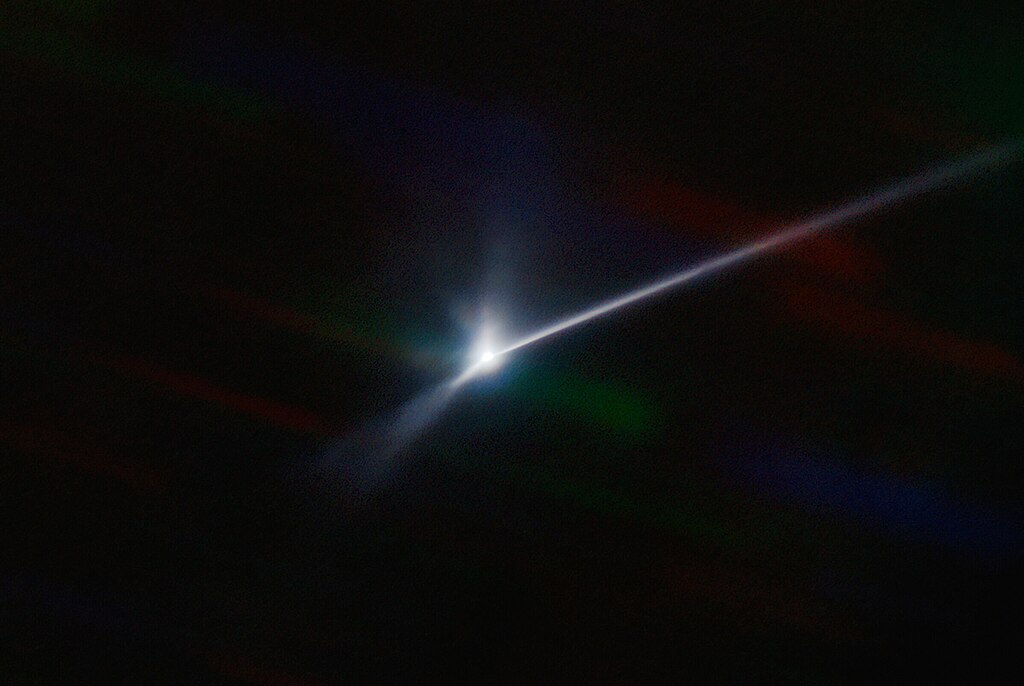
Dimorphos Dust
On October 3, 2022, this image was taken through the SOAR telescope in Chile and shows the debris field resulting from the DART collision with Dimorphos. Stretching for around 10,000 km, the dislodged matter is being blown by radiation pressure from the Sun.
This shot, nebulous and indistinct, stands in vivid contrast to the sharp focus on engineering responsible for creating the swarm seen above. In so doing, it proves that mankind no longer needs to live under the cloud of a different kind - the threat of extinction by a much larger impact similar to ones that have already occured here.

Dimorphos Dust
On October 3, 2022, this image was taken through the SOAR telescope in Chile and shows the debris field resulting from the DART collision with Dimorphos. Stretching for around 10,000 km, the dislodged matter is being blown by radiation pressure from the Sun.
This shot, nebulous and indistinct, stands in vivid contrast to the sharp focus on engineering responsible for creating the swarm seen above. In so doing, it proves that mankind no longer needs to live under the cloud of a different kind - the threat of extinction by a much larger impact similar to ones that have already occured here.
Media Credit:
https://noirlab.edu/public/images/noirlab2223a/
via Wikimedia Commons, CC BY 4.0







